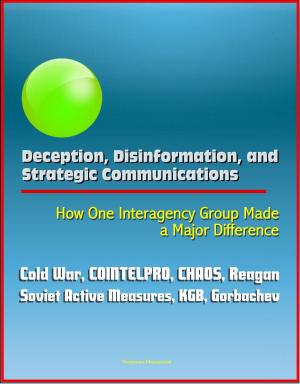Strategic Air Warfare: An Interview with Generals Curtis E. LeMay, Leon W. Johnson, David A. Burchinal, and Jack J. Catton - World War II, Strategic Air Command SAC, Korean War, Southeast Asia
Nonfiction, History, Military, Nuclear Warfare, Aviation| Author: | Progressive Management | ISBN: | 9781311644176 |
| Publisher: | Progressive Management | Publication: | August 12, 2014 |
| Imprint: | Smashwords Edition | Language: | English |
| Author: | Progressive Management |
| ISBN: | 9781311644176 |
| Publisher: | Progressive Management |
| Publication: | August 12, 2014 |
| Imprint: | Smashwords Edition |
| Language: | English |
Early in June 1984 some thirty-five of the retired four-star generals of the United States Air Force gathered in Washington, D.C., for the annual Senior Statesmen Conference. Each year since the early 1960s the Air Force has invited its retired four-star generals to Washington. From that group in 1984, the Office of Air Force History invited four general officers—Generals Curtis E. LeMay, Leon W. Johnson, David A. Burchinal, and Jack J. Catton—to participate in a group oral interview on the history of strategic air warfare. They accepted and on June 15, 1984, at Boiling Air Force Base, the four discussed for nearly three hours the development and evolution of strategic air warfare. Because the session ended without time for a discussion of the Cuban Missile Crisis and the Vietnam War, the four conferred again, this time by telephone, to discuss these and other issues not considered earlier. This interview was the third in a series begun by the Office of Air Force History with the "senior statesmen," the first in 1982 covering air superiority in World War II and Korea, the second in 1983 discussing the type of aerial interdiction used in World War II, Korea, and Vietnam. The purpose of the interview was to have the air commanders meet in an informal setting and discuss the development of strategic air employment as a form of warfare. The hope was that in the course of the discussion these men, who had served together for many years and undergone common experiences, might stimulate each other to remember facts and events that have otherwise gone unrecorded, and to flesh out the record with fuller explanations of motives and the reasoning behind great occurrences. The result was beyond our expectations, for almost immediately the four generals began interviewing each other, reminiscing at times, exchanging ideas, questioning circumstances, and recalling motives and objectives clear at the time of decision but clouded over by the passage of time. Often a single question led to four or five others generated from within the group
Contents: Strategic Air Warfare * Preparations for World War II * World War II: Europe * World War II: The Pacific * The Late 1940s * Korean War * SAC in the 1950s and Early 1960s * The War in the Southeast Asia * Leadership
Strategic Air Warfare is part of a continuing series of historical volumes produced by the Office of Air Force History in direct support of Project Warrior. Since its beginnings Project Warrior has captured the imagination of Air Force people around the world and reawakened a keener appreciation of our fundamental purpose as a Service: to deter war, but to be prepared to fight and win should deterrence fail. Military history helps provide a realistic perspective on warfare. Through the study of past events, we gain insight into the capabilities of armed forces and, most importantly, a sound knowledge of the policies, strategies, tactics, doctrine, leadership, and weapons that have produced success in battle. Each of us, in broadening our knowledge of air power's past, helps to maintain the most effective Air Force possible, now and in the future.
Early in June 1984 some thirty-five of the retired four-star generals of the United States Air Force gathered in Washington, D.C., for the annual Senior Statesmen Conference. Each year since the early 1960s the Air Force has invited its retired four-star generals to Washington. From that group in 1984, the Office of Air Force History invited four general officers—Generals Curtis E. LeMay, Leon W. Johnson, David A. Burchinal, and Jack J. Catton—to participate in a group oral interview on the history of strategic air warfare. They accepted and on June 15, 1984, at Boiling Air Force Base, the four discussed for nearly three hours the development and evolution of strategic air warfare. Because the session ended without time for a discussion of the Cuban Missile Crisis and the Vietnam War, the four conferred again, this time by telephone, to discuss these and other issues not considered earlier. This interview was the third in a series begun by the Office of Air Force History with the "senior statesmen," the first in 1982 covering air superiority in World War II and Korea, the second in 1983 discussing the type of aerial interdiction used in World War II, Korea, and Vietnam. The purpose of the interview was to have the air commanders meet in an informal setting and discuss the development of strategic air employment as a form of warfare. The hope was that in the course of the discussion these men, who had served together for many years and undergone common experiences, might stimulate each other to remember facts and events that have otherwise gone unrecorded, and to flesh out the record with fuller explanations of motives and the reasoning behind great occurrences. The result was beyond our expectations, for almost immediately the four generals began interviewing each other, reminiscing at times, exchanging ideas, questioning circumstances, and recalling motives and objectives clear at the time of decision but clouded over by the passage of time. Often a single question led to four or five others generated from within the group
Contents: Strategic Air Warfare * Preparations for World War II * World War II: Europe * World War II: The Pacific * The Late 1940s * Korean War * SAC in the 1950s and Early 1960s * The War in the Southeast Asia * Leadership
Strategic Air Warfare is part of a continuing series of historical volumes produced by the Office of Air Force History in direct support of Project Warrior. Since its beginnings Project Warrior has captured the imagination of Air Force people around the world and reawakened a keener appreciation of our fundamental purpose as a Service: to deter war, but to be prepared to fight and win should deterrence fail. Military history helps provide a realistic perspective on warfare. Through the study of past events, we gain insight into the capabilities of armed forces and, most importantly, a sound knowledge of the policies, strategies, tactics, doctrine, leadership, and weapons that have produced success in battle. Each of us, in broadening our knowledge of air power's past, helps to maintain the most effective Air Force possible, now and in the future.















